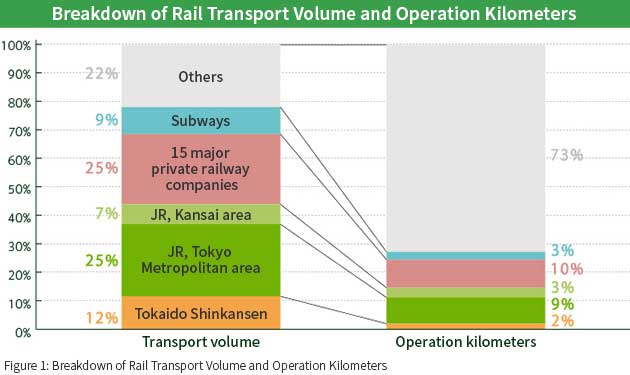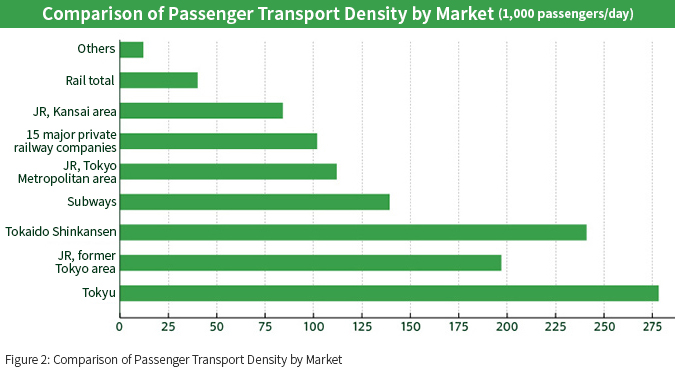There has been a lot of news about railways in recent years, including the 50th anniversary of the inauguration of the Tokaido Shinkansen, the launch of operation of the Hokuriku Shinkansen and the start of construction of the Linear Chuo (SCMAGLEV) Shinkansen. In addition, the momentum of revaluing railways as an energy-efficient, clean mode of transport is heightening amid the growing public interest in energy conservation and global environmental protection. The Hokkaido Shinkansen is scheduled to start operation in the spring of 2016. Moreover, in January this year, the government and ruling parties officially decided to bring forward the scheduled service launch for new Shinkansen lines in the Hokkaido, Hokuriku and Kyushu areas.
In the latter half of the 20th century when motorization became predominant also in countries other than the United States, railways were said to be a dying legacy of the 19th century. However, the fate of railways seemed to take an unexpected upturn in this century. Against this backdrop, we often hear of the “renaissance or revival of railways” in recent years.
In my opinion, however, this rosy prospect for railways is just an illusion. Forced to downsize due to a transport volume decrease in the era of depopulation, railways should spend the rest of their days calmly as the former “king of land transport” that supported the rapid economic growth of Japan.
When considering the viability of rail transport in the future, we must firstly face the fact that rail transport is a niche industry. Here, passenger transport, definitely familiar to every reader, will be examined by comparing railroads with the other modes of transportation, such as automobiles and airplanes.
Firstly, in terms of convenience in traveling relatively short distances, railways cannot outperform automobiles, which can provide door-to-door transport from home or office to the destination. The reason why people use trains (and buses) for commuting in large cities is that the costs of alternative modes of transport (expenses for parking lots and taxies) are too expensive for the majority of the people. As evidence, commuting by automobile is a common practice in areas where land prices are low and parking lots are available (virtually) free of charge. Even in large cities, a handful of people who can afford such costs commute to work by automobile not by railway. In fact, even presidents and top executives of railway companies commute by chauffeur driven cars. Most people use railways not because they prefer to do. They simply have no choice but to choose railways due to costs, for the purpose of traveling.
In terms of speed for long distance travel, railways are no match for airplanes. Although it depends on how easy it is to access an airport from downtown, when people travel a distance of several hundred kilometers, which usually takes them more than three hours by rail, passengers’ first choice is airplanes even in Japan, which has highly developed railway networks. Currently, the Shinkansen line service running the longest route (1,200 km) and taking the longest time (five hours) is “Nozomi” operating from Tokyo to Hakata. However, less than 10% of the people traveling from Tokyo to Hakata use the Shinkansen, that is, more than 90% of the people use airplanes for the distance.
Outperformed by automobiles in convenience and by airplanes in speed, railways must find a niche between automobiles and airplanes in order to remain viable. Yet, a niche is not necessarily small in size. Even though railways may be a reluctant choice for users, if there are advantageous conditions for railway operators, the share of railways can be significant, unfittingly for the word, “niche.” In fact, Japan is one of the few countries in the world where such advantageous conditions exist in the passenger rail service segment.
Now, what are the conditions advantageous to railway passenger transport, which are unique to Japan?
Chiefly it is the concentration of population in large cities. In Japan, there are a number of densely populated large cities from Sapporo in the north to Fukuoka in the south, including the three large urban areas of Tokyo, Osaka and Nagoya. Due to the above-mentioned reasons, a majority of the people have little choice but to use railways as a means of traveling (commuting in particular) willingly or not.
In addition, in the area called “Tokaido,” a belt-line zone measuring just several tens of kilometers wide and 500 kilometers long, Japan’s three largest urban centers and other major cities are located in a row, forming industrial and population clusters rarely seen elsewhere in the world. Therefore, there are tremendous needs for medium- to long-distance inter-city transport, which cannot be accommodated with airplanes that have limited capacity.
Against this backdrop, there are three rail transport markets in Japan, each of which handles one of the world’s largest transport volumes. They are intra-area transport markets in the Tokyo Metropolitan area and the Kansai area, and inter-city transport using the Tokaido Shinkansen. Let’s examine respective traffic volumes using data.
One of the important indicators of transport volume by mode of transport is passenger-kilometers, which is calculated by aggregating each passenger multiplied by the distance travelled. Currently, the annual passenger-kilometers by rail in Japan are approximately 400 billion passenger-kilometers (approx. 250 billion pkm for JR and approx. 150 pkm for other than JR) per year.
Figure 1 shows the shares of rail transport volume (100 million passenger-kilometers) and operation kilometers of Japan in FY2012, occupied by JR’s three major markets (the Tokyo Metropolitan area, the Kansai area and the Tokaido Shinkansen); 15 major private rail companies; subways; and others. The figure indicates that the five categories that account for just 25% of the total operation kilometers have an approximately 80% share in transport volume. (Note that Tokyo Metro, which is often included in the major private railway companies, is categorized as “Subways” here. Half of the subway transport volume is accounted for by Tokyo Metro.)

Next, let’s examine transport density, an indicator for measuring operating efficiency. The transport density represents the average number of passengers on a particular railway line. It is considered the key to understanding the viability of the railway business. “A transport density of 1,000 passengers per day” means that on average 1,000 passengers take trains on a whole line daily, with inbound and outbound services combined.
Figure 2 is a bar chart comparing transport densities by market category. This also reveals that Japan’s passenger rail demand is highly concentrated in the Tokyo Metropolitan area, the Kansai area and the Tokaido Shinkansen. Conversely, transport volume and density are both low in areas where population densities are not so high. The transport density of Others, which includes every Shinkansen line except Tokaido and accounts for three fourths of the total operation kilometers of Japan’s passenger rail service, is limited to around 10,000 passengers per day.

Needless to say, the most characteristic feature of railways is the capability of mass transport. Therefore, in a depopulating society, the scope of the niche for railways will gradually be narrowed. Even in markets where the railway’s feature has been proven advantageous so far, cases will undoubtedly increase, in which we will find it socially desirable for railways to be withdrawn and replaced by other modes of transport.
Ryohei Kakumoto, one of the key figures in the construction project of the Tokaido Shinkansen as well as a high-ranking officer of Japanese National Railways (JNR) in the 1950s and 60s, already argued such as below in Tetsudo to Jidosha (Railways and Automobiles) published in 1968. Then he was a member of the JNR audit committee.
“As automobiles appeared when railways were already in wide use, the mission of railways today is not to provide all land transport services. Rail transport should be limited to segments in which the cost is lower than that by automobile, or where services are far superior to those by automobile. By limiting railway lines to these fields, the service contents of rail transport will be enhanced and railways can contribute to national welfare. We must sweep away outdated obsession for railways.”
Railway operators are now required to cool-headedly implement selection and concentration.
Although I have mentioned the need for a selection and concentration strategy in the preceding paragraphs, I am not saying that all underperforming lines should be abolished. For example, it may be preferable to maintain a rail service even subsidized by taxpayers’ money for such cases as commuting transport for junior and senior high school students.
Previously, “speed” and “punctuality” were always considered bottlenecks in discussions aimed at replacing loss-making local railway lines with buses. Bus Rapid Transit (BRT) is a promising option that may bring about a solution to these issues.
BRT is a transportation system based on a bus running on dedicated roads or lanes. This system has been in practical use across the world, as the system offers the flexibility of buses and the convenience of railways at the same time, and construction costs are low. Many of the readers may well know this system, since East Japan Railway Company has introduced the BRT system instead of restoring the Kesennuma railway line that was damaged by the tsunami of the Great East Japan Earthquake. The former site of rail tracks are used as dedicated busways, the system therefore, not affected by traffic congestion, can assure an on-time, high-speed operation. As the BRT buses can also run on regular city roads besides the dedicated busways, the service can flexibly be extended to schools, hospitals or other points where many passengers wish to go.
As the example above shows, if the service equivalent to or better than that of railways can be offered at a lower cost, we have no reason to maintain railways, rather we should not. In my opinion, we should firstly consider shifting to regular or BRT-based bus transport for not only disaster-affected areas but also other underused railway routes (with a transport density of less than 2,000 passengers per day). This is what we should aim at to revitalize regional transport systems in the 21st century.
In our world, there is a wide range of demands considered necessary from the viewpoint of the public interest. Meanwhile, there is a limit to manpower and physical resources available to us. It is extremely difficult to decide which demand we should prioritize and how to meet such demand. However, we cannot evade “efficiency.” Even if we ignore efficiency, this “ruthless beauty” will never leave us alone. What awaits us is revenge in form of falling standards of living caused by inefficiency.
Once rail tracks are laid, it is difficult to make changes and it is not easy even to adjust railway widths. In short, railways lack flexibility. In contrast, it is much easier to change vehicles and aircraft as well as routes. Automobiles and airplanes are highly capable of flexibly responding to changes in demand.
Moreover, railways require enormous costs for maintenance and repair as compared with automobiles and airplanes. In developing countries, automobiles and airplanes are widely used. However, because of difficulties in maintenance, the conditions of the railway facilities, including those constructed with technical cooperation from Japan, have deteriorated. Railways often fail to fulfill their intended functions.
Going forward, passenger transport should basically be provided primarily by automobiles and airplanes, with railways providing a service only where automobiles and airplanes cannot do it satiscatorily. Even in the case that passenger transport service with the input of taxpayers’ money can be justified, the public interest resides in “transport” itself, not in a specific mode of transport.
I believe that time has come when railways, which have become a niche industry, should be freed from “the spell of public interest.” Without being enchanted by the mirage of rail renaissance, we should keep ourselves from placing exaggerated hopes on them. Instead, while respecting the former “king of land transport,” we should allow railways to live their remaining days peacefully.
(This column is as of 2015.)